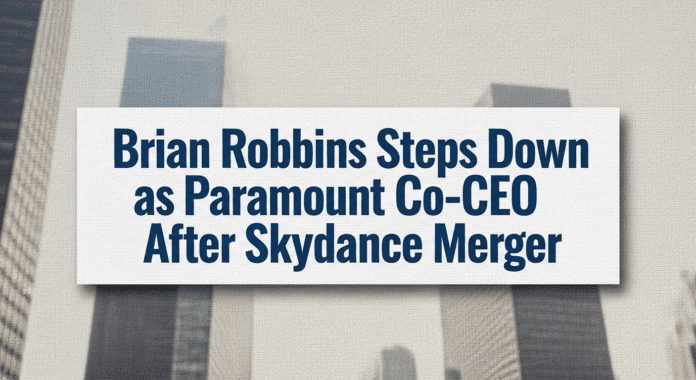Entertainment Giant Faces Leadership Shakeup as $8 Billion Deal Reshapes Hollywood
Brian Robbins’ departure as Paramount Global’s co-CEO marks the end of a transformative chapter for one of Hollywood’s most storied studios. The executive, who played a crucial role in growing Paramount+ into a competitive streaming platform, announced his decision to step down following the completion of Paramount’s $8 billion merger with Skydance Media on August 7, 2025.
This leadership transition signals more than just a changing of the guard. It represents a seismic shift in how traditional media companies adapt to survive in today’s streaming-dominated landscape. For industry watchers and entertainment fans alike, Robbins’ exit raises important questions about what comes next for Paramount’s streaming ambitions and theatrical strategy.
The Man Behind Paramount’s Streaming Success
Brian Robbins didn’t arrive at Paramount through the typical corporate executive pathway. His background as an actor, producer, and director gave him unique insights into both creative storytelling and business strategy. This combination proved invaluable during his tenure as co-CEO, which began in April 2024.
Under Robbins’ leadership, Paramount+ achieved several notable milestones. The platform’s family content strategy paid dividends, with shows like the “Knuckles” spinoff series becoming the most-watched children’s program on the service. The show racked up over 11 million global viewing hours in its first 28 days, proving Robbins’ instinct for audience-driven content.
His approach to franchise management also yielded impressive results. During his time leading Paramount Pictures and later as co-CEO, Robbins helped revitalize major properties including “Transformers,” “Sonic the Hedgehog,” “Mission: Impossible,” and “Teenage Mutant Ninja Turtles.” These efforts contributed to more than $6 billion in global box office revenue.
Perhaps most importantly, Robbins understood the delicate balance between theatrical releases and streaming content. His decision to shift films like “Smile” from streaming to theatrical release demonstrated this strategic thinking. The horror film became the top-grossing original horror movie of the year and one of Paramount’s most profitable films in a decade.
The $8 Billion Skydance Deal That Changed Everything
The merger between Paramount Global and Skydance Media represents one of the most significant media deals in recent years. The transaction, which values the combined entity at $28 billion, creates a new powerhouse called Paramount Skydance Corporation.
David Ellison, CEO of Skydance Media, will lead the merged company, while Jeff Shell takes on the role of president. This leadership team brings together Skydance’s innovative approach to content creation with Paramount’s legacy assets and distribution network.
The deal’s timeline reveals the complexity of modern media mergers. Initially announced on July 7, 2024, the agreement faced multiple regulatory hurdles. The SEC and European Commission approved the merger in February 2025, followed by final FCC approval on July 24, 2025. These delays pushed the closing date from the original April 2025 deadline to August 7, 2025.
For Paramount shareholders, the deal provides both immediate cash returns and long-term equity stakes. They received $4.5 billion in cash and shares, while Skydance’s investor group acquired National Amusements, Paramount’s parent company, for $2.4 billion.
Industry Reactions and Market Implications
The merger has generated significant buzz throughout Hollywood and on Wall Street. Industry analysts view the deal as a strategic necessity for Paramount, which faced mounting debt and declining cable viewership. The combination with Skydance provides access to fresh capital and new expertise in areas like animation, sports content, and video games.
However, reactions haven’t been uniformly positive. Some industry insiders have expressed concerns about potential job cuts and cultural integration challenges. The merger is expected to result in significant layoffs as the companies eliminate redundancies and streamline operations.
In his departure memo, Robbins struck a reflective tone about his time at Paramount. “This moment of transition is, of course, bittersweet,” he wrote. “But I step away with deep pride in what we’ve built together and with great confidence in the road ahead. The company is in exceptionally capable hands with David Ellison and the incoming team from Skydance.”
The memo highlighted key achievements during Robbins’ tenure, including 17 number-one box office releases and the record-breaking success of “Top Gun: Maverick,” which earned $1.5 billion globally.
What This Means for Streaming Competition
Robbins’ departure comes at a critical juncture for the streaming industry. Paramount+ has made significant strides but still lags behind established players like Netflix, Disney+, and Amazon Prime Video. The new leadership team faces the challenge of accelerating growth while managing costs in an increasingly competitive market.
One intriguing possibility is a potential merger between Paramount+ and Peacock, NBCUniversal’s streaming service. Industry speculation suggests such a combination could generate an additional $1 billion in annual revenue, creating a more formidable competitor to the streaming giants.
The new Paramount Skydance Corporation plans to leverage Skydance’s content production expertise to enhance Paramount+’s original programming. This includes expanding into international markets where the platform has historically underperformed.
Challenges and Opportunities Ahead
The merged entity faces both significant opportunities and substantial challenges. On the opportunity side, combining Paramount’s extensive content library with Skydance’s blockbuster production capabilities could create compelling new programming for both theatrical and streaming audiences.
Skydance’s success with franchises like “Top Gun: Maverick” demonstrates their ability to create culturally resonant content that performs well globally. Integrating this expertise with Paramount’s television production and children’s content could yield impressive results.
However, challenges remain substantial. The company must address Paramount’s debt burden while investing in new content and technology. Competition for top talent and premium content continues to intensify, driving up costs across the industry.
The new leadership team also faces regulatory and political pressures. Under recent FCC guidance, the merged entity has committed to eliminating diversity, equity, and inclusion programs, which could create internal tensions and reputational risks.
The Broader Hollywood Landscape
Robbins’ departure reflects broader trends reshaping Hollywood’s executive ranks. Traditional media companies are increasingly turning to leaders with technology and streaming expertise as they navigate digital transformation.
The success of streaming platforms has fundamentally altered how content creators, distributors, and consumers interact. Executives like Robbins, who successfully bridged traditional theatrical distribution with streaming strategy, have become increasingly valuable in this transition period.
For consumers, these changes translate into more content choices but also more complex viewing decisions. As platforms consolidate and differentiate their offerings, audiences must navigate an ever-expanding array of subscription services.
Looking Forward
As Paramount Skydance Corporation begins operations, the entertainment industry will be watching closely to see how successfully the new leadership team executes their vision. The integration of two distinct corporate cultures presents both opportunities for innovation and risks of operational disruption.
The company’s streaming strategy will be particularly important to monitor. With David Ellison at the helm and industry veterans like Cindy Holland overseeing direct-to-consumer operations, Paramount+ may be positioned for accelerated growth.
For Brian Robbins, his departure marks the end of a successful chapter in his career but likely not the end of his influence on the industry. His approach to balancing creative vision with business strategy has proven effective in the modern entertainment landscape.
We want to hear from you about these industry changes. How do you think the Paramount-Skydance merger will impact your viewing choices? What kind of content are you hoping to see from the combined company? Share your thoughts in the comments below and let us know which streaming strategies you think will succeed in this competitive market.




